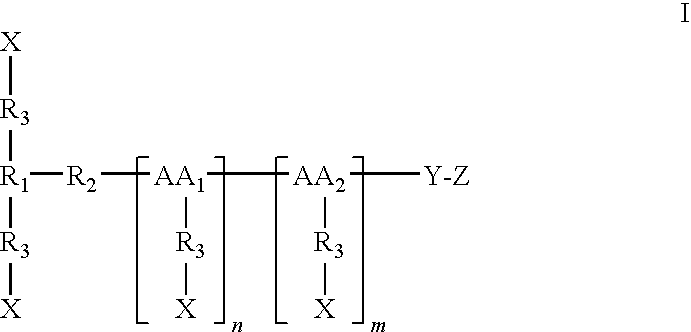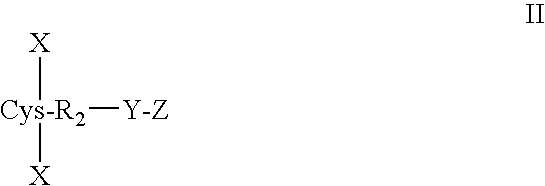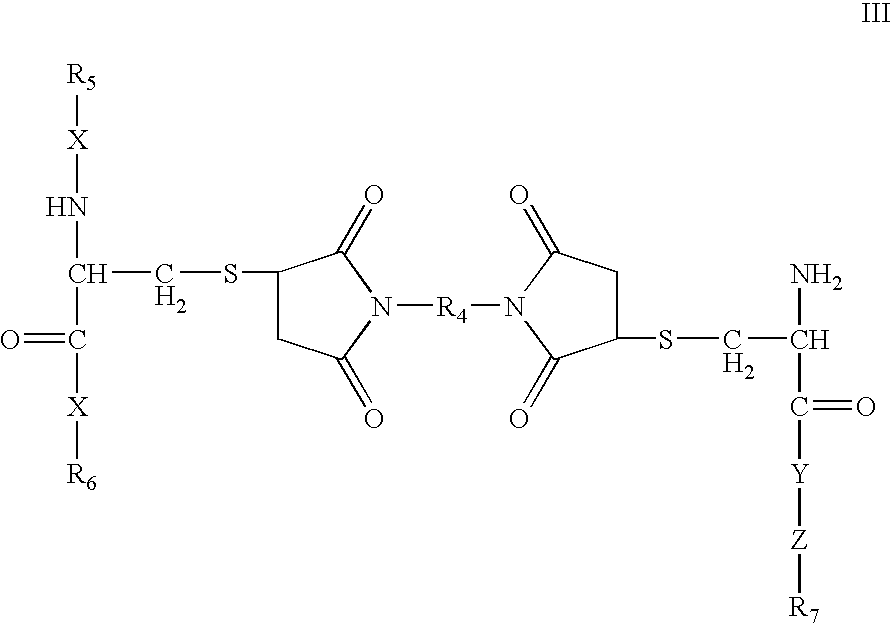Cysteine-branched heparin-binding growth factor analogs
a growth factor and heparin-binding technology, applied in the field of cysteine-branched can solve the problems of high preparation cost, general difficulty in preparation, and none of these or other known heparin-binding growth factor analogs provide the advantages
- Summary
- Abstract
- Description
- Claims
- Application Information
AI Technical Summary
Benefits of technology
Problems solved by technology
Method used
Image
Examples
example 1
[0198]A synthetic branched peptide construct of the general formula: NH2-LYVDFSDVGWNDWC(bMB-CX1X1X1X1RKRLDRIAR-amide)-LYVDFSDVGWNDW-amide, where bMB is 1,4-bis-maleimidobutane and each X1 is 6-aminohexanoic acid, is synthesized using two peptide precursors. The first peptide precursor is CX1X1X1RKRLDRIAR-amide (SEQ ID NO:56), again where each X1 is 6-aminohexanoic acid, while the second peptide precursor is LYVDFSDVGWNDWCLYVDFSDVGWNDW-amide (SEQ ID NO:57). Both peptide precursors are synthesized by conventional solid phase methods and purified by reverse-phase HPLC. In the first peptide precursor, CX1X1X1RKRLDRIAR-amide (SEQ ID NO:56), the cysteine residue serves to link the precursor to 1,4-bis-maleimidobutane, the 6-aminohexanoic acid X1X1X1 tripeptide serves as both a spacer and provided a hydrophobic region, and the sequence RKRLDRIAR (SEQ ID NO:58) provides a heparin-binding motif derived from a modification of the sequence at residues 270-279 of the Jun / AP-1 DNA binding domain...
example 2
[0202]The synthetic branched peptide construct of Example 1 is tested in cell growth studies, to determine the ability of the synthetic branched peptide construct to stimulate cell growth. Cell growth is monitored using a commercially available kit (Promega Corporation, Madison, Wis.) based on a tetrazolium compound (3-(4,5-dimethylthiazol-2-yl)-5-(3-carboxymethoxyphenyl)-2-(4-sulfophenyl)-2H-tetrazolium, inner salt (MTS). Aliquots of 103 cells are seeded into wells of 96-well plates and allowed to attach. The medium is then replaced with a low serum medium containing between 0 and 10 μg / mL of the synthetic branched peptide construct of Example 1. After 3 days in culture, the relative cell number is monitored using MTS following the directions of the manufacturer. Statistical significance is determined using ANOVA followed by post-hoc multiple comparisons versus control group (Dunnett's Method).
[0203]MC3T3E1 osteoblastic cells, C3H10T1 / 2 mouse pluripotent stem cells, C2C12 murine my...
example 3
[0204]In an alternative method of synthesis, a first peptide precursor chain NH2—C(Npys)X1X1X1RKRLDRIAR-amide (SEQ ID NO:59) is synthesized by conventional peptide synthesis methods, where each X1 is 6-aminohexanoic acid and C(Npys) is S-(3-nitro-2-pyridinesulfenyl)-cysteine. The second peptide precursor chain AISMLYLDENEKVVLCAISMLYLDENEKVVL-amide (SEQ ID NO:60), is synthesized as in Example 1. The sequence AISMLYLDENEKVVL (SEQ ID NO:28) is derived from amino acids 87-100 in the human BMP-2 sequence. As shown in Synthetic Scheme 2, the two chains are reacted, resulting in a disulfide bond between the two sulfur atoms (S1 and S2) of the cysteine residues of SEQ ID NO. 59 and SEQ ID NO:60, respectively.
PUM
| Property | Measurement | Unit |
|---|---|---|
| Molar density | aaaaa | aaaaa |
| Molar density | aaaaa | aaaaa |
| Fraction | aaaaa | aaaaa |
Abstract
Description
Claims
Application Information
 Login to View More
Login to View More - R&D
- Intellectual Property
- Life Sciences
- Materials
- Tech Scout
- Unparalleled Data Quality
- Higher Quality Content
- 60% Fewer Hallucinations
Browse by: Latest US Patents, China's latest patents, Technical Efficacy Thesaurus, Application Domain, Technology Topic, Popular Technical Reports.
© 2025 PatSnap. All rights reserved.Legal|Privacy policy|Modern Slavery Act Transparency Statement|Sitemap|About US| Contact US: help@patsnap.com



